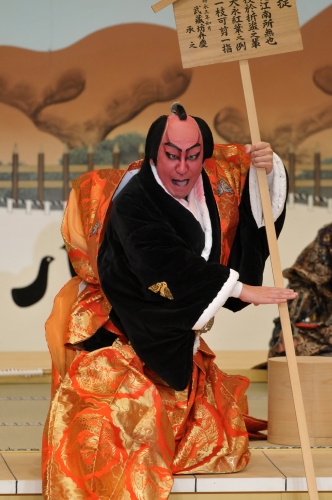Kabuki Plus
He who breaks a branch will lose a finger
A cherry tree still stands at Suma Temple in Kobe that is believed to have been loved by the 12th-century General Yoshitsune. It is an important set piece in this drama. The signboard, supposedly left by Yoshitsune, plays on a homonym for branch, finger and son. The playwright overlays the story with the Suma Temple legend.
Head inspection
notable!Head inspections were carried out by troupe leaders to ascertain the enemy’s identity. With no photographs, it was not always easy to determine whether the head is really the enemy, and the inspections would sometimes involve cross examinations of captured enemies. Head inspections involved detailed protocol. In Kabuki, substitute heads are often used as crucial storylines.
Signboard mie
notable!Signboards in Kabuki indicate various rules such as forbidden acts. At the head inspection scene, Kumagai removes the signboard and presents it to Yoshitsune together with the head container. Using the signboard, he stops the two women from approaching the head in a famous mie pose. The mie is like a stop motion, heightening the suspense of the moment. The signboard mie represents Kumagai’s emotion as he seeks the validity of his judgment from Yoshitsune.
Danjuro style and Shikan style
notable!
The scene commonly uses the Danjuro style, passed down from Danjuro VII. It emphasizes inner emotions. In the original script, Kumagai only cuts off his topknot, but he now shaves his head to stress his becoming a monk. The current ending is also a modern addition. He whispers the “16 years” line on the hanamichi, puts on a straw hat and disappears to the plaintive sound of the shamisen, conveying his sorrow.
The Shikan style, rarely performed nowadays, is considered a classic approach more focused on form. Kumagai’s costume is black velvet with red brocade, and he wears red makeup called Shikan kumadori, representing a tough warrior. The signboard mie is also different. In final scene, his hair is as the original, and the “16 years” line is expressed in a self-deprecating manner.
【Photo】
Period piece
Kumagai’s Camp is Act III of a famous period piece A Chronicle of the Battle of Ichinotani. Period pieces were like samurai drama for Edo audiences and set in a time prior to Edo. This play, first performed in 1751, centers on a battle fought in 1184. Thus, for audiences at the time, the events were already more than 550 years in the past, much further than the Edo Period is to us.
One other story
The full-length play also includes another episode from The Tale of Heike. The principal role is Tadanori, a Heike warrior known as a poet. Because the Heike clan was expelled from the capital, his poems were nearly ejected from a famous poetry anthology.Genji leader Yoshitsune recommended its inclusion under “poet unknown”. Notification was done through a note tied to a cherry tree branch, which Yoshitsune orders delivered to Tadanori. Tadanori is ultimately killed by the messenger.
Playwright Namiki Sosuke
Namiki Sosuke (1695-1751) is one of the playwrights of Kabuki’s Big Three masterpieces. He was said to have studied at a temple when young, and specialized in multi-layered tragedies with deep insight into human behavior. A Chronicle of the Battle of Ichinotani draws from The Tale of Heike but transforms it into a complex story with unexpected twists. The author’s plays create breathtaking conflicts of love and emotion, and pain and sorry from cruel choices. As in Edo, modern audiences enjoy being tricked by Sosuke’s fictional historical dramas.